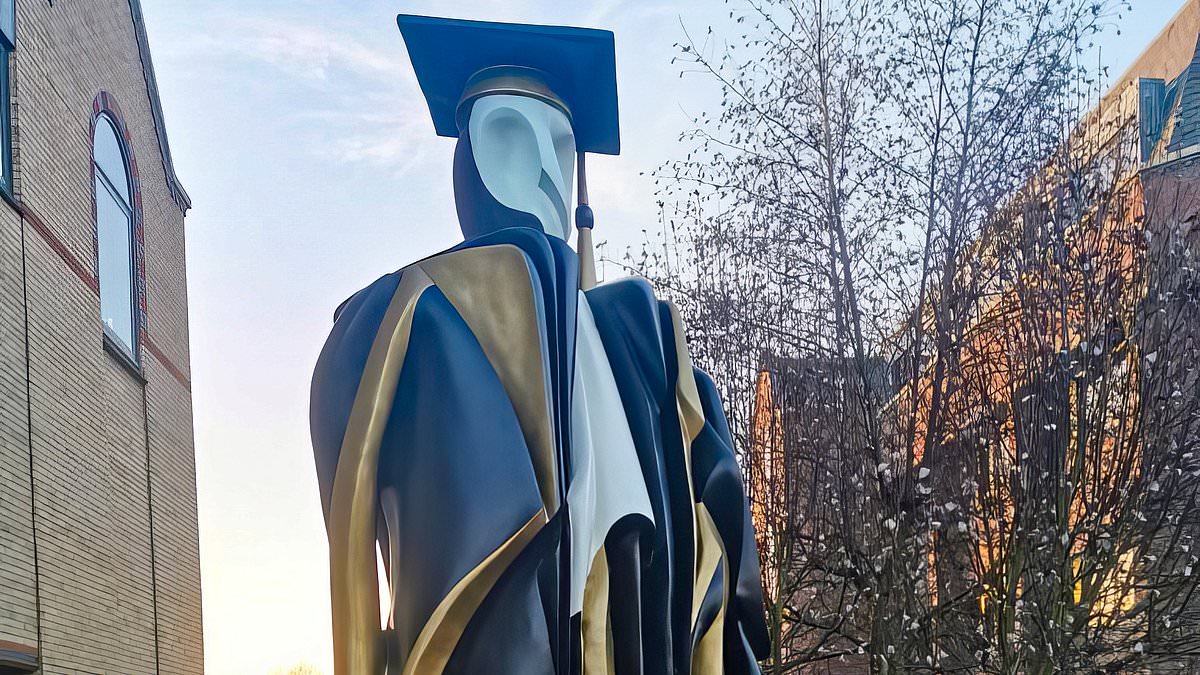A bronze sculpture of Prince Philip deemed ‘possibly the poorest quality work’ ever submitted must be removed after planning bosses refused permission, as supporters slammed the decision as ‘censorship’.
The 13-foot-high bronze sculpture, which cost £150,000 and was described as having a ‘harmful material impact’ on the area, appeared in Cambridge one morning without any prior warning to residents.
Now the planning inspectorate has ruled ‘The Don’ must be removed from its post on the corner of Hills Road and Norwich Street in a ruling that brought a months’-long planning battle to an end.
But not all are happy, with some residents accusing the council of ‘jumping on the bandwagon’ of removing statues of historical figures.
The work of art, which represents Prince Philip in his role as Vice Chancellor of Cambridge University, appeared suddenly at its current location in July, but has been the subject of a planning permission row since March.
City planners refused permission for the statue to be displayed outside a new office block on Hills Road in 2014, describing it as the worst piece of public art they had ever seen.
An enforcement notice issued by the Greater Cambridge Shared Planning Service (GCSP) on March 5 said it appeared the sculpture had been erected within the last four years without planning permission.
The enforcement notice said it has a ‘harmful material impact’ on the appearance of the area and that it was contrary to policies in the Cambridge Local Plan.
It said the sculpture must be permanently removed along with its foundations and plinth within four months from April 11, unless an appeal is made beforehand.
But its owners, Unex Ltd, argued the statue didn’t require planning permission because it was not a development.
In June it launched a fight to keep the statue in its original position.
The city council’s planning committee disagreed due to the fact the sculpture weighs three tonnes and stands four meters tall.
In a statement released yesterday, city councillors said the refusal for planning permission for the statue had been upheld by the planning inspectorate and that the statue would have to go.
Katie Porrer, a Market ward councillor who campaigned against the statue said: ‘When this statue appeared in such a prominent location with no notice, no consultation and no planning permission, ward councillors worked with residents and the council to enforce against this.
‘The owner then pursued an appeal at a costly public enquiry, claiming that the statue did not need planning permission at all, despite being 3 tonnes in weight and installed with no discussion with residents, and then that even if it did need permission, it should be granted!
‘The inspector instead agreed with the council’s view that it was a development which required permission and then rejected permission as the development had not complied with the public art requirements in the city.
‘He also ruled that the owner should pay his costs.
‘We are very grateful to the council officers who worked extremely hard on this appeal to put over our case to the inspector, as well as the many local residents who joined with ward councillors to put forward their views, and to those who spoke at the public appeal.’
Proving that beauty is in the eye of the beholder, not all residents support the council move to take down the statue.
One man who works on the same street, but asked to remain anonymous told previously: ‘I don’t know why they are singling it out, I like it.
‘I think it will be a shame to lose it, maybe they have an issue because it’s Prince Philip, but I don’t see the harm of recognising the royals with a statue.
‘There is now censorship but we are all meant to have freedom in this country so we should be able to put up a statue of notable figures instead of jumping on the bandwagon of the historical ones that have been torn down in recent times.
‘I think it could have something to do with personal opinions rather than the canvasing the public first.’
Elizabeth Large, who also wanted the statue to stay, added: ‘It’s art – it does not necessarily need to look human or like a person.’
The artwork was originally attributed to Uruguayan sculptor Pablo Atchugarry, but he later disowned the piece.
Atchugarry, who is an internationally renowned sculptor, whose pieces have been sold at Christies and Sothebys in London, New York, Paris and Amsterdam, called the accusation it was his work ‘an abuse.’
He said in 2014, ‘I am not the author of this sculpture, and it is an abuse that they had used my name.
‘I wish somebody would apologise to me for this misunderstanding’.
But Bill Gredley, the chairmen of Unex Group who developed the piece, staunchly defended the work in 2014 and described it as a ‘spectacular piece of art.’
A spokesman for Unex group added in 2014: ‘Mr Gredley and others consider it is a rather spectacular bronze with a difference, namely the head and shape as cast together with the bronze being coloured black to resemble the academic clothing and mortarboard.
‘Mr Gredley appreciates that art is subjective and therefore has no issue with those who do not like The Don.’
